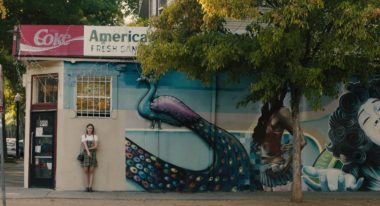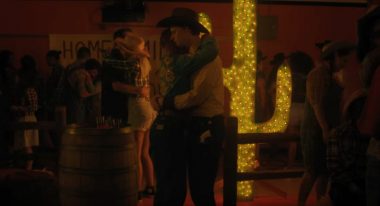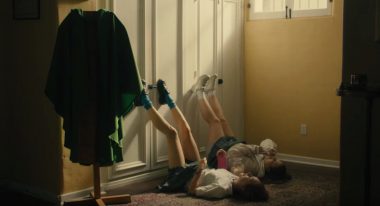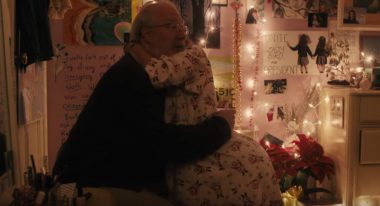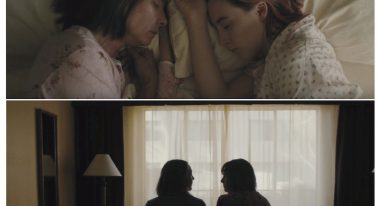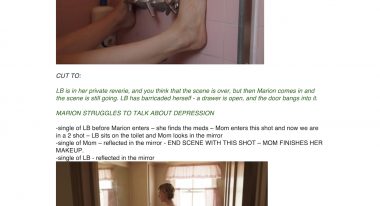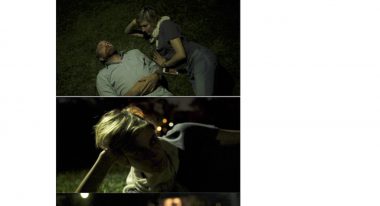 Back to selection
Back to selection
Shutter Angles
Conversations with DPs, directors and below-the-line crew by Matt Mulcahey
“If You Want That Melodramatic Shaft of Light, You’d Better Mean It”: DP Sam Levy on Shooting Lady Bird
 Saiorse Ronan in Lady Bird
Saiorse Ronan in Lady Bird There’s a tradition of young directors looking for inspiration in the bygone eras of their adolescence. For George Lucas in American Graffiti, it was the California car culture of the early ’60s. For Richard Linklater in Dazed and Confused, it was the Texas high school rituals of the ’70s. And for Greta Gerwig in Lady Bird, it’s Catholic school and the suburban doldrums of early-aughts Sacramento.
Written and directed by Gerwig, Lady Bird follows the titular character (Saoirse Ronan) through her senior year of high school as she fights with her mom (Laurie Metcalf), pines for a philosophical dilettante from the neighboring all-boys school (Timothée Chalamet), and dreams of escaping Sacramento for college on the East Coast.
The film’s 2003 setting is recent enough that its memory hasn’t yet fossilized in the amber of obstinate nostalgia. That allowed Gerwig and cinematographer Sam Levy (Frances Ha, While We’re Young) to define their own aesthetic for the period – the look of a memory several generations removed from its original source, like a Xerox copy of a color photograph.
With a Golden Globe win for Best Musical or Comedy under Lady Bird’s wing and the Academy Award nominations announcement looming next week, Levy spoke to Filmmaker about creating period by amplifying Arri Alexa grain, using light as a symbol of grace and seeking inspiration in John Huston’s boxers-on-the-brink classic Fat City.
Filmmaker: For Lady Bird, you and Greta began prepping nearly a year before the start of official preproduction. That sounds like a rare luxury.
Levy: It was indeed a luxury. My official prep time on Lady Bird was six weeks; fairly standard for a cinematographer. But because Greta and I have been friends for many years and live not far from each other in downtown Manhattan, we decided to break down her script prior to official prep. [Check out the bottom of this interview for Levy and Gerwig’s shotlists from a pair of scenes].
Filmmaker: I’ve read about non-filmic influences for Lady Bird’s look – the portraits of Lise Sarfati and the pastel palette of Sacramento painter Wayne Thiebaud. But I haven’t heard you talk too much about what films you and Gerwig watched and discussed during that prep period.
Levy: We didn’t watch any films until we completed a first draft of our shot list. Both of us wanted Lady Bird to be original. Sometimes when you watch too many movies in prep, whether you intend it or not, your own voice can get drowned by the style of the reference material. Greta and I both stopped watching TV shows during the entire time we worked on Lady Bird for this reason.
In this spirit we happily prepared a blueprint for the visual architecture of Lady Bird. Once we had a first draft, we looked at Fat City, simply because it’s my favorite film. It was photographed by the great Conrad Hall. Greta pointed out that Fat City was filmed in Stockton, CA, just 50 miles from Sacramento, where Lady Bird is set. Fat City has wonderful day exteriors and some of the most breathtaking day interiors you will ever see onscreen. It’s a film that is appreciated by cinephiles, shown at repertory houses, but is highly underappreciated in regard to the quality of its photography. To me, it’s cinematographically astonishing.
We also looked at The 400 Blows for scenes in classrooms, Paper Moon to watch fast-paced dialogue shot dynamically with very little “coverage,” and Chantal Akerman’s Jeanne Dielman to see scenes of a mother doing repetitious chores at home and caring for her son.
Filmmaker: You did extensive prep work for the film’s locations, which were all shot at practical spots. Walk me through the prep you did just for Lady Bird’s house.
Levy: Greta and I looked at about 50 locations for Lady Bird’s family house before we discovered the one that appears in the movie. I had a good feeling as soon as we walked in, but until you walk the entire perimeter of a location it’s best to withhold judgment. I’m always looking to see if the available light is any good, if the flow of rooms is going to help me build dynamic shots and give me enough depth. Once we walked the perimeter, Greta and I glanced at each other and nodded. This was it. Our brilliant 1st AD Jonas Spaccarotelli was right behind us. We both looked to him and the three of us smiled at each other. Having the affirmation of fellow filmmakers you trust is always a good sign. This was the place.
I immediately made my first light studies. I took Greta around to all of the rooms and photographed her and Jonas standing in for our actors. I did this with my Fuji X-T1 still camera. I took hundreds of shots and made diagrams of the sun’s trajectory throughout the day. I came back several times at different points in the day with my Fuji and made more tests. Just still photos. I tried to spend as much time in that house as possible to live with the light.
Then we came back two weeks before principal photography and shot all kinds of tests with our Arri Alexa camera and Panavision lenses. My still photos and time spent at the house informed how I tested. We brought the actors to the house and shot them in every single room. Here, I worked very closely with production designer Chris Jones and costume designer April Napier. It was important that the rooms and costumes have color synchronicity. We worked very carefully to focus our tests in a specific area. I’ve learned the hard way to be disciplined in testing. I try to have a clear goal in mind. For Lady Bird, I was trying to transform the sometimes-harsh Sacramento sunlight into a radiant glow that takes your breath away.
How to do this? By spending time with the light and really looking at it. Stand and observe. Part of the discipline of testing has to do with turning off your phone and contemplating light. Not just through a viewfinder and especially not on a TV monitor. I want to look at the real thing, not a facsimile. Little by little, the answers come, and then shooting the film becomes an expression of this.
Filmmaker: You chose Panavision Super and Ultra Speeds for Lady Bird. Why were those a good fit?
Levy: I tested Ultra Speeds for a different project prior to Lady Bird. I loved how they looked, but they weren’t a good fit for the other film. I knew that Lady Bird was coming down the road and I always had them in mind.
The Ultra Speeds rendered the pastel lemon-colored Sacramento sun into a more radiant butterscotch. They are not as sharp as modern lenses, but saying they are soft does not adequately describe what makes them special. It’s specially-made glass that renders faces and light in an impressionistic manner.
Filmmaker: I believe you used the Zeiss Super Speeds on While We’re Young. How is the look of those lenses different than the Panavision glass?
Levy: The Zeiss Super Speeds are sharper and have an inkier contrast to them. They don’t flare as much as the Ultra Speeds. The set I used on While We’re Young was manufactured by Zeiss in the 1980s. They have an icy, indigo blue in the shadow area. They naturally love blue in the midtones and shadows. The Ultra Speeds tend to steer the image towards a warmer, luminous brassiness.
Filmmaker: This idea of making Lady Bird look like a “memory” is something that came up in every other interview about the film that I read, but I haven’t really heard you talk specifically about how you technically created that look. Can you break down the technique for me?
Levy: I’d be happy to.
Filmmaker: Did you use on-camera filtration to soften?
Levy: Never. The Ultra Speeds are innately diffuse and required no filtration.
Filmmaker: How did you tease out the grain in the Alexa?
Levy: Teasing out the native Alexa grain was largely the result of underexposing the image and then having my colorist Alex Bickel brighten it back up after the fact. I sometimes underexposed the image by as many as three stops in camera. I rated the camera at 1280 for day exteriors and 1600 for most of the interior work and we shot 2K ProRes.
Filmmaker: What tweaks did you make in the DI? Did you add a grain pass?
Levy: It was important to Greta and I not to take pre-packaged film grain and overlay it on Lady Bird. Instead, we sought to take the native noise floor of the Alexa, which embodied our Kinko’s photocopied aesthetic, and amplify it. In our DI, Alex and I found a way to isolate the native Alexa grain that we had in our digital negative and selectively amplify it. Alex was a master at this and he taught me about the color science of the Alexa sensor and how to harness it.
It’s all right there in the sensor. Many people try to avoid Alexa noise by overexposing or shooting at the higher resolutions available. But for Greta and I, the Alexa video noise felt very much like a color photocopy. I took it a bit far in a few spots and the grain became too present in the image. Thankfully, Alex was able to dial it back until those scenes looked luminous and special.
Filmmaker: I read an interview with Greta where she talked about eliciting advice from directors she’d worked with. I’m not sure who exactly told her this, but one of the pieces of advice was, “If for some reason you don’t like a shot and you don’t know why, just keep turning off lights.” Are there any scenes in the film that benefitted from that piece of advice?
Levy: As a DP, I am constantly doing this! On Lady Bird I worked with a masterful gaffer, Jerry Mundy. Jerry and his team were quick to get the lights up and running. Before inviting Greta to take a look at the frame, I would always ask Jerry to turn off-and-on every light so I could see what they were doing. Many times I would leave certain lamps off or take them down on a dimmer. My goal is generally to work with one primary light source. If Jerry advocated for additional lamps we had a quick process for determining whether they were necessary. Less is more.
To finish the interview, I sent Sam a collection of stills and asked him to write anything he’d like about the images. His responses are below.
Convenience Store. Day Exterior
Levy: On the occasion of Lady Bird’s 18th birthday, she visits a convenience store to buy a pack of cigarettes, a porno mag and a lottery ticket. After buying them, she hangs outside the store and smokes her cigarette. There’s a super funny close-up of Saoirse Ronan that precedes this wide shot: Saoirse is smoking and holding the Playgirl magazine with both hands, cigarette in her mouth. I belly laugh every time I see that close-up. We laughed a lot on set when we shot this scene.
For the frame above, I wanted to shoot just as the sun was dipping below the horizon at the end of the day. I wanted the light to be off of Saoirse and the wall, but touching the trees – you can see it a bit at the top of the frame here.
I love that there is a light brown square just where Saoirse is standing – it was there to paint over some graffiti, but it frames Lady Bird and helps her stand out amid the mural.
I also wanted to see past the store and down the street – you see a slice of depth on the left side of the frame. The long street gives us some depth and offsets the flat wall in a way that I find satisfying.
The Homecoming Dance. Night Interior.
Levy: I can’t speak highly enough of my gaffer Jerry Mundy and the work he did on this scene. We had only two hours to shoot this entire homecoming dance scene. Because we had no time, Jerry and I designed an intricate theatrical lighting setup that he rigged while Greta and I were shooting a day interior scene on the other side of the gym. Jerry is a student of light and comes from a theatrical background. His point of view is unique and I have learned a lot about light from him.
I underexposed this scene quite a bit. My personal memory of these school dances is that they were never brightly lit. So I wanted to capture the sense of a dimly lit school dance where anything can happen. Lady Bird can ask the boy of her dreams to dance and he might actually say yes. In this scene, darkness was our friend.
We placed 30” unbleached muslin lanterns around the room, dimmed down to 30%. When dimmed down that low, the tungsten light becomes reddish gold and looks like glowing butterscotch. From there, we used a 2K Fresnel lamp with a 250 diffusion frame on the right side of the camera. It is focused on Saoirse and Lucas Hedges. I underexposed two and a half stops from the reading I was getting to this 2K.
Our production designer Chris Jones did a wonderful job designing the western theme for this dance. He made the cactus that you see behind Lucas and Saoirse. Jerry collaborated with the art department to design points of light on the cactus and then Chris’s team pushed the Christmas lights through the cardboard. Jerry also placed LiteGear LED ribbon lights on the back of the cactus and dialed in the butterscotch amber setting to throw some light on the couples dancing in the background.
The eating of the holy wafers. Day Interior.
Levy: Greta taught me that in religious paintings, light is a metaphor for grace. Whenever we see light passing through a window, such as in the shot, I kept that idea close to heart.
Set in a priest’s office adjacent to the school chapel, this shot is meant to capture the essence of teenagers whiling away the day. Saoirse and Beanie Feldstein are killing time, eating holy wafers and making each other belly laugh.
The shot before this one is an overhead close-up of Beanie and Saoirse – they appear upside-down in the frame. It’s an inversion of the first shot of the movie, where we see an overhead of Lady Bird and her mom. From that two-shot, we cut out to the wider shot pictured above.
We staged the priest’s robe frame left, obscured in shadow. This gives us a sense of where we are. The only light in the shot comes through the small window that you see frame right at the top. Just outside the small window we bounced an Arri 4K HMI into a bead board. The height of the small window created a nice diagonal highlight.
On a different movie, you might use a smoke machine to really see the shaft of light coming through the window. This technique is very common. But it was important to me that the light never overshadowed the girls. A big shaft of light in a scene like this, particularly in a church, risks becoming a caricature of a religious scene. To boot, managing haze requires precision and a skilled technician. It costs money and requires a fire marshal. If you want that melodramatic shaft of light, you’d better mean it.
Lady Bird’s Dad gives her completed financial aid forms. Night Interior.
Levy: This scene begins and ends with a bit of blocking that I love. Tracy Letts, who plays Lady Bird’s dad, knocks on the door and Lady Bird answers. The camera is tilted up from where you see it in this frame. I asked Tracy to hunch down so I could hold both he and Saoirse in the beginning of the frame. From there, he kneels down — camera tilts down with him — to present his daughter with completed financial aid forms for her college application. Lady Bird leaps into his arms and we have the image above.
This scene plays in one shot and we get all of the essential information we need. Jerry supplied the Christmas lights, which are pinned to the wall in the background. Since the movie is set in 2003, we wanted to make sure not to use LED practicals, which did not exist at that time.
The lights have a heavy flare. This is on account of the Panavision Ultra Speed lens that we used. The Ultra Speeds flare heavily when there is a highlight in frame. They tend to make a star pattern, as do most Panavision lenses. I was concerned that with all of the points of light right behind Saoirse, that there would be a flurry of star patterns that might look absurd. Not so. The Ultra Speeds took care of us — if you look carefully at the Christmas lights in this shot, you will see tiny star patterns, but they are subtle and did not bother me.
The opening two shots of the movie. Bedroom Day Interior.
Levy: This was the very first thing Greta and I discussed when we first broke down her script. After mapping out the blocking, we discussed how we wanted to show the intimacy of mother and daughter.
We have light coming through a window in the second of these two frames. Greta and I discussed how this style of light, in religious paintings, speaks to the relationship between Mary and Jesus. We looked at many of these paintings, as well as portraits of mothers and daughters by Mary Cassatt.
Greta told me to keep in mind that Lady Bird and her mom are most intimate when they are unconscious in the first frame of the film. We will never see them be this close to each other for the rest of the film. When we cut to the second shot, we see the two women in silhouette, sitting on the bed. Eventually they turn and face the window, and look away from us. Greta and I were very excited about this tableau. Wherever possible, we looked to create proscenium frames within the movie, dynamic tableaus that the characters could inhabit — a frame within the frame. When the two actors look out the window in front of them, it’s as though they are about to watch the movie with us.
Matt Mulcahey works as a DIT in the Midwest. He also writes about film on his blog Deep Fried Movies.
